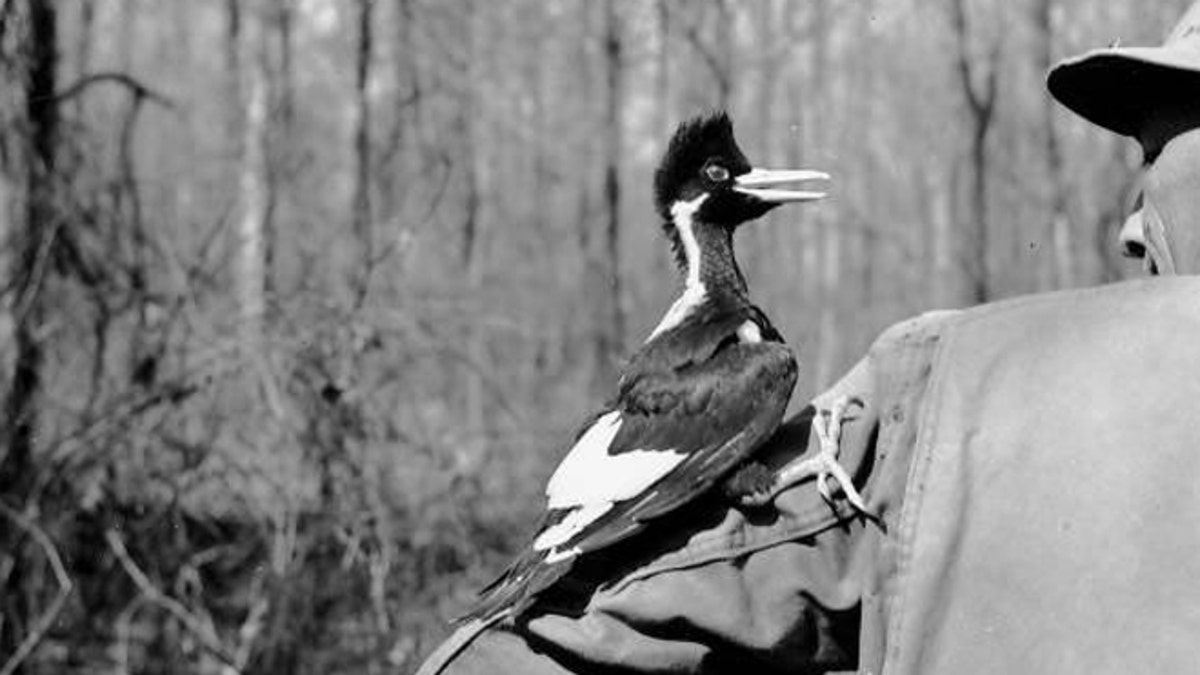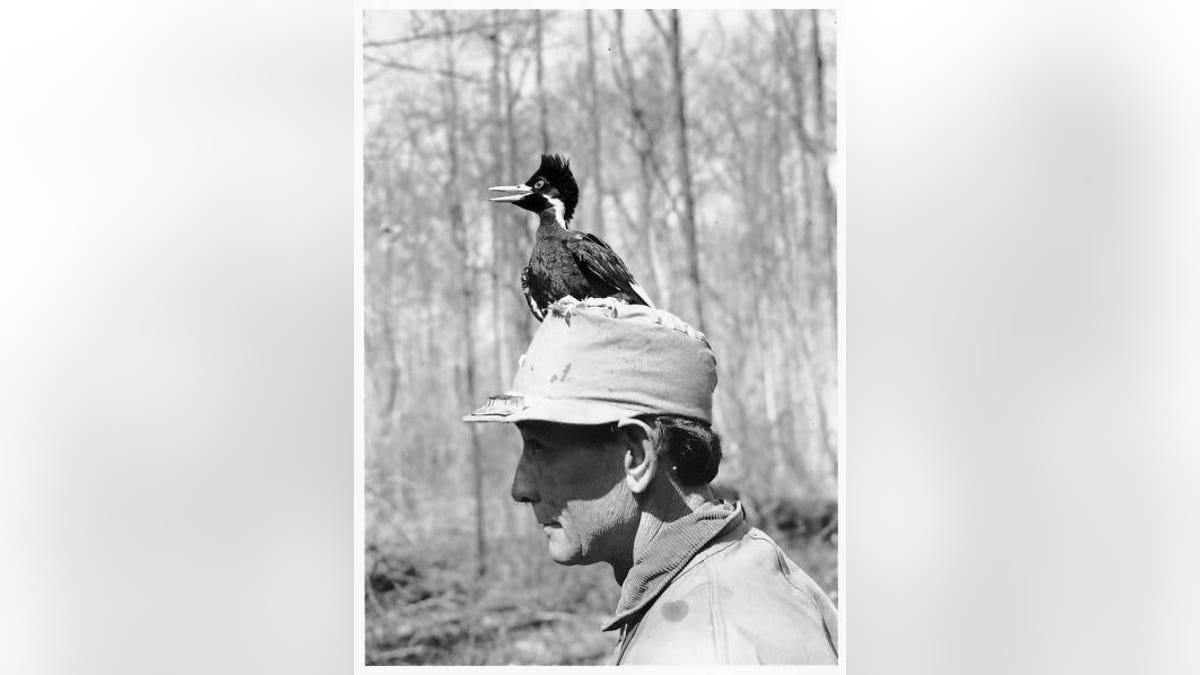
Nestling ivory-billed woodpecker on J.J. Kuhn, March 6, 1938 (U.S. Fish and Wildlife Service)
It’s a mystery that has both fascinated and confounded everyone from ornithologists at top-tier universities to casual weekend bird-watchers for decades.
Are there still ivory-billed woodpeckers roaming the wilds of the southeastern United States or have they all gone extinct?
While the bird has not been photographed since the 1930s, a new study conducted by a researcher at the Naval Research Laboratory posits that - despite the lack of definitive evidence of the species’ existence - the so-called “Lord God bird” is not extinct and its habitat needs to be protected if the woodpecker hopes to thrive.
Michael Collins, who works at the Stennis Space Center in southeastern Mississippi and has made researching the ivory-billed woodpecker a pet project of his for more than a decade, published his findings in the online journal Heliyon. In his study, Collins presents evidence - including three video that show birds he believes to be the ivory-billed woodpecker – that he says proves that the elusive bird is not extinct.
PRIMATE STUDY FIND IT'S 'WORSE THAN WE THOUGHT'

Nestling ivory-billed woodpecker and J.J. Kuhn, March 6, 1938 (U.S. Fish and Wildlife Service)
“You’re not going to find the birds by going out and looking for them for a week or even a year,” Collins, who spent 1,500 hours between 2005 and 2013 in Mississippi and Louisiana’s Pearl River region looking for the woodpecker, told Fox News. “Over eight years of intense research I’ve only had 10 sightings of the bird.”
Among his research is video footage Collins shot while kayaking and climbing trees of the purported woodpecker’s signature swooping flights, rapid wingbeats, and audible double-knock. These findings are consistent with reports of sightings of the bird made back in the 1940s.
The ivory-billed woodpecker - one of the largest woodpeckers in the world – saw its numbers dwindle in the late 19th century due to widespread deforestation from the Southeast’s burgeoning logging industry as well as hunting. By 1938, an estimated 20 woodpeckers remained in the wild and six years later the last known ivory-billed woodpecker, a female, was gone.
While not officially labelled as extinct, the species is listed as critically endangered and possibly extinct by the International Union for Conservation of Nature. Alleged sightings in Arkansas in 2004, however, renewed hope among conservationists that the woodpecker still existed and led Collins to conduct his research.
GOODNIGHT, COLO! OLDEST GORILLA IN THE US DIES IN SLEEP
“There is no logical reason to conclude that the population is less than it was in the 1920s,” Collins said. “I really doubt they are extinct.”
Others, however, are not so sure.
Steve Milloy, author and founder of the blog JunkScience, contends that that there is no hard evidence that the bird is still alive and the reports of sightings are just meant to keep land from being developed.
“As JunkScience.com exposed in February 2006, alleged sightings of the Ivory-billed woodpecker are just a trick to keep land from being developed,” Milloy said on JunkScience.
SHARK'S 'VIRGIN BIRTH' MAKES HISTORY, COULD SAVE HER SPECIES
Milloy argues that the sightings of the woodpecker in 2004 were organized and supported by the Nature Conservancy as the organization stood to benefit substantially from the sightings and possibly be granted $10.2 million federal dollars and hundreds of thousands of acres in Arkansas.
“Given that the land acquisition is made possible with taxpayer dollars and tax breaks — for who knows what ultimate purposes – you can almost hear the Nature Conservancy laughing like that other fictional woodpecker, Woody Woodpecker, all the way to the bank,” Milloy wrote in an article for Fox News in 2006.
When contacted by Fox News, a spokeswoman for the Nature Conservancy could neither confirm nor deny that the organization received any federal funding related to the project.
Prominent ornithologists across the U.S. don’t dismiss Collins’ claims that he has spotted the ivory-billed woodpecker, but say that more concrete evidence needs to be obtained before a definitive answer to whether or not this species still exists is given.
HUGE GATOR SPOTTED TAKING STROLL IN FLORIDA RESERVE
"Mike [Collins] lays out good arguments. It certainly doesn't settle the issue — there's nothing definitive in what he presents — but it's an interesting case." Geoff Hill, an ornithologist at Auburn University, said of Collins’ research back in a 2011 interview with LiveScience, "Of course, whether something is 'definitive' is to some degree a matter of opinion."
A clear image of the bird is what ornithologists and bird-watchers are all hoping to get to prove the woodpecker’s existence, but Collins is doubtful that will ever happen given a number of factors. The large area of its habitat, the dense swamp forest where it is known to reside and the fact that it travels miles from its nest for food all stack the odds against researchers looking to snap a photo of the bird.
“It’s unlikely anyone will get a clear photo,” Collins said. “It’s like a perfect storm of factors.”
Until that image is captured, everyone can agree that the debate over the bird that John James Audubon described as "graceful to the extreme" will continue.




















